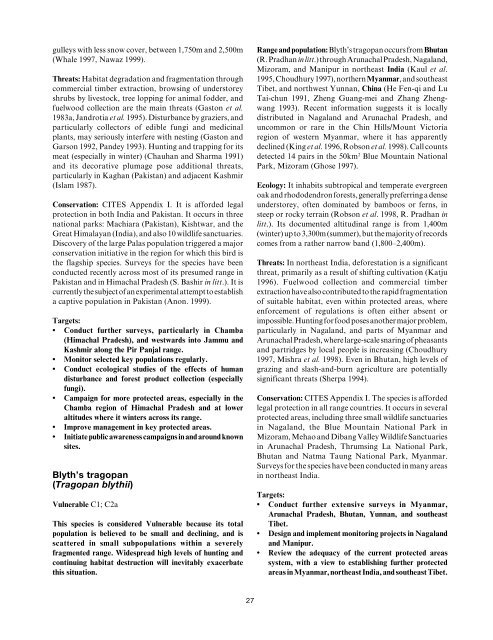Pheasants: Status Survey and Conservation Action Plan ... - IUCN
Pheasants: Status Survey and Conservation Action Plan ... - IUCN
Pheasants: Status Survey and Conservation Action Plan ... - IUCN
Create successful ePaper yourself
Turn your PDF publications into a flip-book with our unique Google optimized e-Paper software.
gulleys with less snow cover, between 1,750m <strong>and</strong> 2,500m<br />
(Whale 1997, Nawaz 1999).<br />
Threats: Habitat degradation <strong>and</strong> fragmentation through<br />
commercial timber extraction, browsing of understorey<br />
shrubs by livestock, tree lopping for animal fodder, <strong>and</strong><br />
fuelwood collection are the main threats (Gaston et al.<br />
1983a, J<strong>and</strong>rotia et al. 1995). Disturbance by graziers, <strong>and</strong><br />
particularly collectors of edible fungi <strong>and</strong> medicinal<br />
plants, may seriously interfere with nesting (Gaston <strong>and</strong><br />
Garson 1992, P<strong>and</strong>ey 1993). Hunting <strong>and</strong> trapping for its<br />
meat (especially in winter) (Chauhan <strong>and</strong> Sharma 1991)<br />
<strong>and</strong> its decorative plumage pose additional threats,<br />
particularly in Kaghan (Pakistan) <strong>and</strong> adjacent Kashmir<br />
(Islam 1987).<br />
<strong>Conservation</strong>: CITES Appendix I. It is afforded legal<br />
protection in both India <strong>and</strong> Pakistan. It occurs in three<br />
national parks: Machiara (Pakistan), Kishtwar, <strong>and</strong> the<br />
Great Himalayan (India), <strong>and</strong> also 10 wildlife sanctuaries.<br />
Discovery of the large Palas population triggered a major<br />
conservation initiative in the region for which this bird is<br />
the flagship species. <strong>Survey</strong>s for the species have been<br />
conducted recently across most of its presumed range in<br />
Pakistan <strong>and</strong> in Himachal Pradesh (S. Bashir in litt.). It is<br />
currently the subject of an experimental attempt to establish<br />
a captive population in Pakistan (Anon. 1999).<br />
Targets:<br />
• Conduct further surveys, particularly in Chamba<br />
(Himachal Pradesh), <strong>and</strong> westwards into Jammu <strong>and</strong><br />
Kashmir along the Pir Panjal range.<br />
• Monitor selected key populations regularly.<br />
• Conduct ecological studies of the effects of human<br />
disturbance <strong>and</strong> forest product collection (especially<br />
fungi).<br />
• Campaign for more protected areas, especially in the<br />
Chamba region of Himachal Pradesh <strong>and</strong> at lower<br />
altitudes where it winters across its range.<br />
• Improve management in key protected areas.<br />
• Initiate public awareness campaigns in <strong>and</strong> around known<br />
sites.<br />
Blyth’s tragopan<br />
(Tragopan blythii)<br />
Vulnerable C1; C2a<br />
This species is considered Vulnerable because its total<br />
population is believed to be small <strong>and</strong> declining, <strong>and</strong> is<br />
scattered in small subpopulations within a severely<br />
fragmented range. Widespread high levels of hunting <strong>and</strong><br />
continuing habitat destruction will inevitably exacerbate<br />
this situation.<br />
Range <strong>and</strong> population: Blyth’s tragopan occurs from Bhutan<br />
(R. Pradhan in litt.) through Arunachal Pradesh, Nagal<strong>and</strong>,<br />
Mizoram, <strong>and</strong> Manipur in northeast India (Kaul et al.<br />
1995, Choudhury 1997), northern Myanmar, <strong>and</strong> southeast<br />
Tibet, <strong>and</strong> northwest Yunnan, China (He Fen-qi <strong>and</strong> Lu<br />
Tai-chun 1991, Zheng Guang-mei <strong>and</strong> Zhang Zhengwang<br />
1993). Recent information suggests it is locally<br />
distributed in Nagal<strong>and</strong> <strong>and</strong> Arunachal Pradesh, <strong>and</strong><br />
uncommon or rare in the Chin Hills/Mount Victoria<br />
region of western Myanmar, where it has apparently<br />
declined (King et al. 1996, Robson et al. 1998). Call counts<br />
detected 14 pairs in the 50km 2 Blue Mountain National<br />
Park, Mizoram (Ghose 1997).<br />
Ecology: It inhabits subtropical <strong>and</strong> temperate evergreen<br />
oak <strong>and</strong> rhododendron forests, generally preferring a dense<br />
understorey, often dominated by bamboos or ferns, in<br />
steep or rocky terrain (Robson et al. 1998, R. Pradhan in<br />
litt.). Its documented altitudinal range is from 1,400m<br />
(winter) up to 3,300m (summer), but the majority of records<br />
comes from a rather narrow b<strong>and</strong> (1,800–2,400m).<br />
Threats: In northeast India, deforestation is a significant<br />
threat, primarily as a result of shifting cultivation (Katju<br />
1996). Fuelwood collection <strong>and</strong> commercial timber<br />
extraction have also contributed to the rapid fragmentation<br />
of suitable habitat, even within protected areas, where<br />
enforcement of regulations is often either absent or<br />
impossible. Hunting for food poses another major problem,<br />
particularly in Nagal<strong>and</strong>, <strong>and</strong> parts of Myanmar <strong>and</strong><br />
Arunachal Pradesh, where large-scale snaring of pheasants<br />
<strong>and</strong> partridges by local people is increasing (Choudhury<br />
1997, Mishra et al. 1998). Even in Bhutan, high levels of<br />
grazing <strong>and</strong> slash-<strong>and</strong>-burn agriculture are potentially<br />
significant threats (Sherpa 1994).<br />
<strong>Conservation</strong>: CITES Appendix I. The species is afforded<br />
legal protection in all range countries. It occurs in several<br />
protected areas, including three small wildlife sanctuaries<br />
in Nagal<strong>and</strong>, the Blue Mountain National Park in<br />
Mizoram, Mehao <strong>and</strong> Dibang Valley Wildlife Sanctuaries<br />
in Arunachal Pradesh, Thrumsing La National Park,<br />
Bhutan <strong>and</strong> Natma Taung National Park, Myanmar.<br />
<strong>Survey</strong>s for the species have been conducted in many areas<br />
in northeast India.<br />
Targets:<br />
• Conduct further extensive surveys in Myanmar,<br />
Arunachal Pradesh, Bhutan, Yunnan, <strong>and</strong> southeast<br />
Tibet.<br />
• Design <strong>and</strong> implement monitoring projects in Nagal<strong>and</strong><br />
<strong>and</strong> Manipur.<br />
• Review the adequacy of the current protected areas<br />
system, with a view to establishing further protected<br />
areas in Myanmar, northeast India, <strong>and</strong> southeast Tibet.<br />
27
















